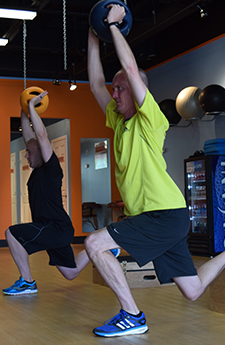A Little Strength Goes a Long Way
Training to achieve any running goal is exciting. We develop a plan of attack and set about conquering our goals. And then… we get injured. Ugh.
The high injury rate for runners is a frustrating reality. Studies suggest that almost 3 out of every 4 runners will develop some sort of injury each year. So, what are we supposed to do? Stop running?
Hardly.
The physical and emotional benefits of running have been just as clearly documented. All physical activity comes with some kind of risk, right? And running is good for us. Heck, it’s excellent for us. So how can we run and avoid becoming a running injury statistic?
 A little strength training can go a long way to help runners avoid the DL. Rather than go into the numerous ways that strength training can help performance, let's focus strictly on strength training as a tool to keep us healthy.
A little strength training can go a long way to help runners avoid the DL. Rather than go into the numerous ways that strength training can help performance, let's focus strictly on strength training as a tool to keep us healthy.
The most common running injuries that beset endurance athletes are overuse or “under-recovery” injuries. These occur due to movement dysfunction and soft tissue imbalances. These imbalances are amplified by the highly repetitive, single-plane activity we all love so much. When you also consider the high impact of running mile after mile, it’s not surprising that issues arise. The race itself is not what breaks most runners. It’s the necessary time on our feet in training that sets us up for injury.
Ask most runners about their primary goals, and almost all of them will mention that they just want to make it to the start line healthy. And, as a coach, my goal is to have my athletes ready to chase their goals on race day. Yet despite compelling evidence supporting the inclusion of strength training in a runner’s program, there are still plenty of runners who just run. They do nothing additional to help themselves develop as all-round, balanced athletes. If we can develop better postural strength and athleticism, our bodies will be better prepared to handle the stresses that training can put on us.
Frequency is the key.
When we talk about adding strength training to our workout regimens, we're not talking about adding two or three 90-minute gym sessions per week. The goal is a frequent and manageable process. We are already investing quite a bit of our spare time to training. Trying to add too much gym time can disrupt the delicate work-life-training balance. If we can simply add in three to five days each week of 20-30 minutes per day of some targeted exercises, our bodies will see the benefits.
Movement not muscle.
It's about functional strength, not bulking up. We want to develop movement patterns. We don’t want to train isolated muscles. We want to develop a balanced body, so our goal in strength training is to activate muscle patterns that are weak or inhibited and relax or loosen those that are tight or overworked. Runners often worry about getting too big and muscular in training. But to be honest, you won't start to look like the hulk unless you train specifically for that outcome. With a targeted strength training program, we'll be able to stay ahead of the stresses that can crumble our running goals. And, no, we won’t get bulky.
Another set of eyes.
My wife will not let me cut my own hair because I'll screw it up. No matter how hard I try, I can't see the back of my head while I cut. Having another set of eyes that can see everything helps me avoiding wearing a hat every day. The same thing holds true when we’re working on training our muscles to get stronger and more balanced. We need that extra set of eyes to make sure we're doing the movement patterns properly. Sure, we'll try to feel what's right. The problem is that if we've already got muscular compensations going on (and in case you were wondering, yes, you do) what we is right typically is not. We need another person there—ideally, a professional—to ensure we are training correctly.
Runners are going to run. It's as simple as that. By adding proper strength training into our training regimen, we will get more out of our running and stay one step ahead of the injury bug. A little strength training can go a long way towards achieving our goals.
 Tim Cary is Fleet Feet's Assistant Training Manager and coach of the Fleet Feet-sponsored Runnababez Elite team. Over his more than two decades of coaching, Tim has coached athletes to three national team championships, five national individual championships, two national records, and numerous All-American and All-State honors. Click here to receive Tim's weekly article via email.
Tim Cary is Fleet Feet's Assistant Training Manager and coach of the Fleet Feet-sponsored Runnababez Elite team. Over his more than two decades of coaching, Tim has coached athletes to three national team championships, five national individual championships, two national records, and numerous All-American and All-State honors. Click here to receive Tim's weekly article via email.
Connect With Us
see the latest from Fleet Feet St. Louis